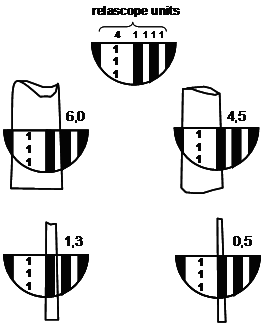Measurement with the relascope
| Line 6: | Line 6: | ||
On that micro-scale there are measurement units (the so-called relascope units) which are being used for the [[Why measuring upper diameters?|measurement of upper diameters]]. Once it is determined, for a particular measurement, to how many centimeters one relascope unit corresponds, we can determine upper diameters by simply counting relascope units (Figure 1). The height, at which the measurement is taken, needs to be determined independently. | On that micro-scale there are measurement units (the so-called relascope units) which are being used for the [[Why measuring upper diameters?|measurement of upper diameters]]. Once it is determined, for a particular measurement, to how many centimeters one relascope unit corresponds, we can determine upper diameters by simply counting relascope units (Figure 1). The height, at which the measurement is taken, needs to be determined independently. | ||
| − | Usually one determines the relascope units by aiming at the known [[Diameter at breast height|dbh]] or any other lower diamater that can be measured directly. If for example a tree has a dbh of 60 cm and we count 6 relascope units when aiming with the relascope at dbh, then we know that each relascope units corresponds to 10 cm. If then for example at height 10 m we count 4. | + | Usually one determines the relascope units by aiming at the known [[Diameter at breast height|dbh]] or any other lower diamater that can be measured directly. If, for example, a tree has a dbh of 60 cm and we count 6 relascope units when aiming with the relascope at dbh, then we know that each relascope units corresponds to 10 cm. If then for example at height 10 m we count 4.5 relascope units, we can calculate the respective diameter of 45 cm from the known relation. |
| − | Another possibility is to use the ratio 1:200. That means, if for example the horizontal distance to the tree is 10 m, one relascope unit would correspond to an object size of 5 cm. The advantage of using this fixed distance is that the relascope can be used to measure the height of the diameter measurement at the same time. | + | Another possibility is to use the fixed ratio between diameter and distance of 1:200 that every small relascope unit represents. That means, if for example the horizontal distance to the tree is 10 m, one relascope unit would correspond to an object size of 5 cm. The advantage of using this fixed distance is that the relascope can be used to measure the height of the diameter measurement at the same time. |
The relascope is complex in design but relatively simple to use. It is quite expensive. Visibility is a problem when light is bad. Of course, counting the relascope units and determine its fractions is difficult, above all for higher angles where the scale is very narrow. | The relascope is complex in design but relatively simple to use. It is quite expensive. Visibility is a problem when light is bad. Of course, counting the relascope units and determine its fractions is difficult, above all for higher angles where the scale is very narrow. | ||
Revision as of 08:23, 16 April 2018

The relascope (the original German name is: Spiegelrelaskop) is a multifunctional hand-held measurement device developed by the Austrian forester Walter Bitterlich. It can be used for the so-called Bitterlich (or angle-count) sampling, for the measurement of upper stem diameters but also for the measurement of slope angle, tree height and other variables. A micro-scale in the device does automatically correct for slope angle.
On that micro-scale there are measurement units (the so-called relascope units) which are being used for the measurement of upper diameters. Once it is determined, for a particular measurement, to how many centimeters one relascope unit corresponds, we can determine upper diameters by simply counting relascope units (Figure 1). The height, at which the measurement is taken, needs to be determined independently.
Usually one determines the relascope units by aiming at the known dbh or any other lower diamater that can be measured directly. If, for example, a tree has a dbh of 60 cm and we count 6 relascope units when aiming with the relascope at dbh, then we know that each relascope units corresponds to 10 cm. If then for example at height 10 m we count 4.5 relascope units, we can calculate the respective diameter of 45 cm from the known relation.
Another possibility is to use the fixed ratio between diameter and distance of 1:200 that every small relascope unit represents. That means, if for example the horizontal distance to the tree is 10 m, one relascope unit would correspond to an object size of 5 cm. The advantage of using this fixed distance is that the relascope can be used to measure the height of the diameter measurement at the same time.
The relascope is complex in design but relatively simple to use. It is quite expensive. Visibility is a problem when light is bad. Of course, counting the relascope units and determine its fractions is difficult, above all for higher angles where the scale is very narrow.
References
- ↑ Kleinn, C. 2007. Lecture Notes for the Teaching Module Forest Inventory. Department of Forest Inventory and Remote Sensing. Faculty of Forest Science and Forest Ecology, Georg-August-Universität Göttingen. 164 S.